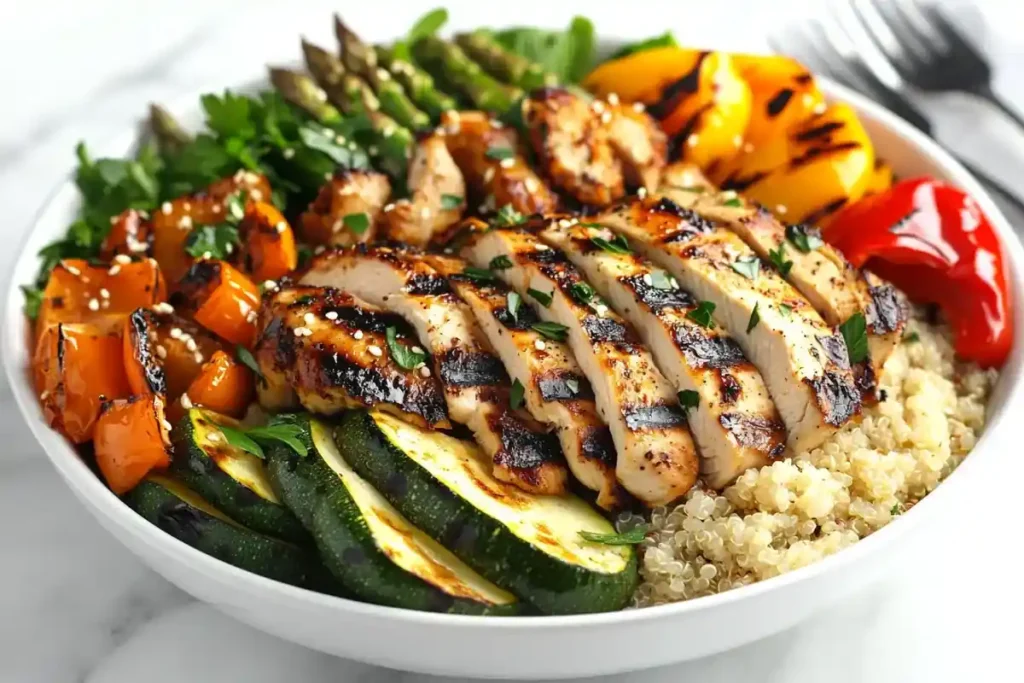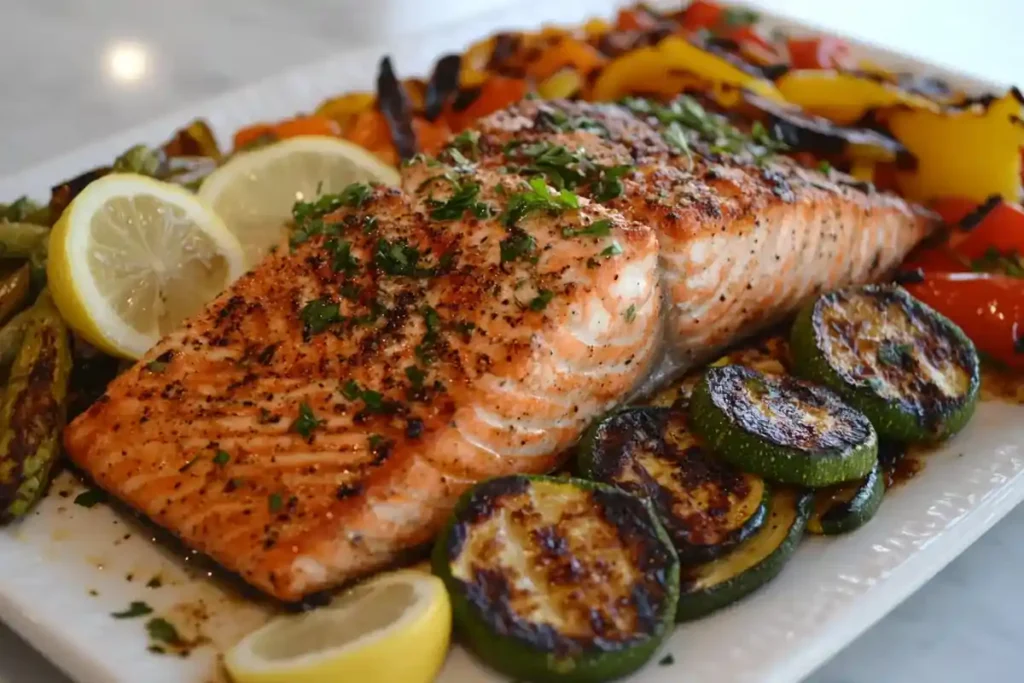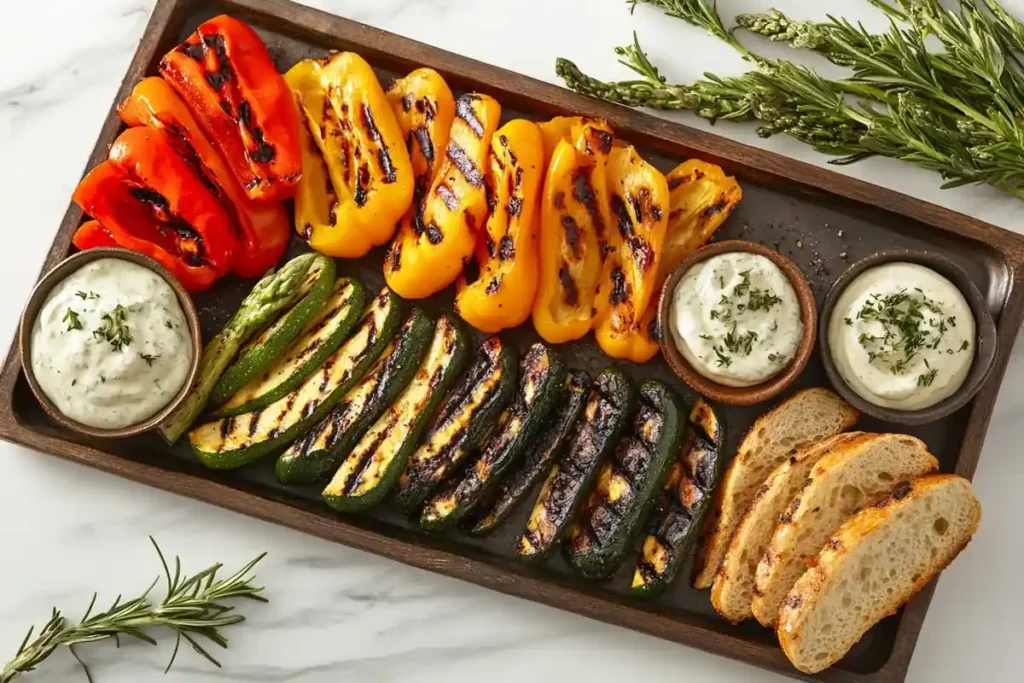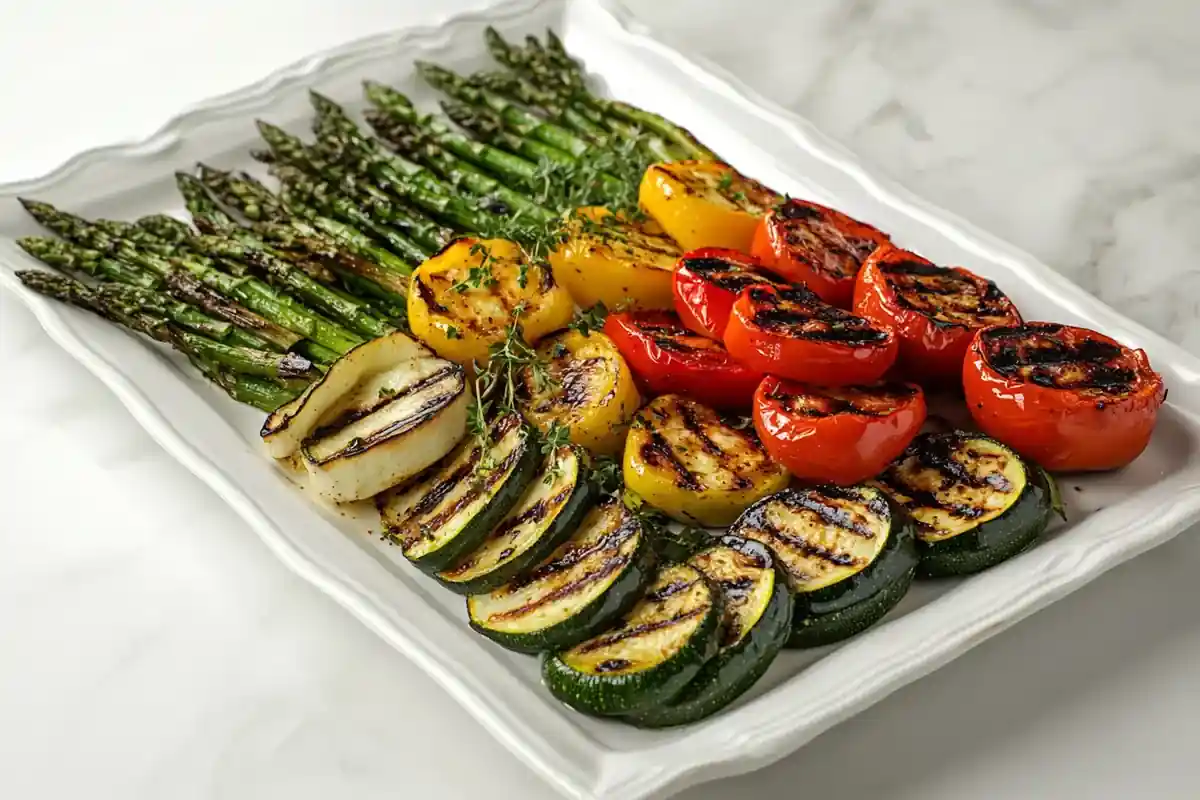What Goes Well with Roasted Vegetables?
Roasted vegetables are a culinary staple, offering a flavorful, nutritious, and Flexible addition to any meal. Whether you’re preparing a hearty dinner or Creating a light lunch, the options for pairing roasted vegetables are endless. This article delves into the best pairings, including proteins, grains, sauces, and sides, while also exploring creative recipes and roasting tips. Let’s uncover what goes well with roasted vegetables and how you can elevate your meals Easily.
Part 1: The Basics of Pairing Roasted Vegetables
Why Roasted Vegetables Are a Flexible Side Dish
Roasting vegetables enhances their natural Savor and earthy flavors. The caramelization process brings out rich, complex tastes, making them a perfect addition to various cuisines. Roasted vegetables are not only delicious but also packed with essential nutrients like vitamins, fiber, and antioxidants, contributing to a balanced diet.
Their versatility means you can serve them with almost anything—from light salads to robust main courses. Roasted vegetables adapt well to different spices and seasonings, giving you endless possibilities to experiment.
Common Flavor Profiles and Pairing Principles
Pairing roasted vegetables is all about balance. Their rich, earthy flavor benefits from complementary tastes such as:
- Savory: Pair with proteins like grilled chicken or salmon.
- Sweet: Add dried fruits like cranberries or drizzle honey for a touch of Savor.
- Tangy: Incorporate sauces like lemon garlic dressing or balsamic glaze to brighten flavors.
- Spicy: Use chili flakes or spicy dips for an extra kick.
To create a well-rounded meal, for instance, consider combining different textures. In particular, the crisp edges of roasted vegetables pair wonderfully with creamy sauces, while crunchy toppings like nuts and seeds add an extra layer of flavor and contrast. Additionally, experimenting with these combinations can elevate your dish, making it both satisfying and memorable.
By thoroughly understanding these pairing principles, for example, you can easily make roasted vegetables the star of any meal. Moreover, in the next section, we’ll dive deeper into the best main dishes to serve with them. So, stay tuned for more inspiring ideas!
Part 2: Best Proteins to Pair with Roasted Vegetables
Grilled and Roasted Meats
When wondering what goes well with roasted vegetables, proteins like grilled chicken, steak, or pork chops come to mind. These meats provide a hearty complement to the natural Savor of roasted veggies. For instance:
- Chicken: Roasted vegetables pair perfectly with herb-marinated grilled chicken. Try combining chicken breasts with a medley of roasted carrots, zucchini, and bell peppers for a balanced plate.
- Beef: A juicy steak with roasted Brussels sprouts and onions is a classic, satisfying option.
- Lamb or Pork: Lamb chops or pork tenderloin with roasted root vegetables like parsnips and sweet potatoes create a robust flavor profile.
These combinations offer both texture and flavor contrasts, making your meals more dynamic.
Seafood Combinations
Roasted vegetables are a great match for seafood, too. The mild, flaky nature of fish contrasts beautifully with caramelized veggies. Consider these pairings:
- Salmon: Pair roasted asparagus and sweet potatoes with seared salmon for a nutrient-rich dish. A drizzle of lemon-butter sauce ties everything together.
- Shrimp: Roasted vegetables like broccoli, bell peppers, and cherry tomatoes work wonderfully with garlic shrimp.
- Cod or Halibut: For lighter options, flaky white fish complements roasted veggies seasoned with olive oil and herbs.
Plant-Based Protein Options
Vegetarians and vegans can also enjoy roasted vegetables with protein-rich plant-based alternatives:
- Tofu or Tempeh: Marinate tofu or tempeh in soy sauce, ginger, and garlic, then roast them alongside your veggies.
- Legumes: Roasted chickpeas or lentils add protein and crunch when served with roasted vegetables in salads or bowls.
- Seitan or Plant-Based Meat: These alternatives mimic the texture of meat and pair well with roasted squash or cauliflower.

Part 3: Grains and Carbohydrates That Complement Roasted Vegetables
Whole Grains for a Balanced Plate
When thinking about what goes well with roasted vegetables, grains are an essential part of the conversation. They provide a hearty base for vegetable dishes and add a nutty, chewy texture. Some great options include:
- Quinoa: This protein-packed grain pairs beautifully with roasted veggies like eggplant, zucchini, and cherry tomatoes. Toss them together with a lemon vinaigrette for a wholesome salad.
- Brown Rice: Serve roasted vegetables over a bed of brown rice for a simple yet filling dish. A sprinkle of chopped herbs like parsley or cilantro adds brightness.
- Farro or Barley: These chewy grains create a hearty base for roasted vegetable bowls. Add a drizzle of balsamic glaze for extra flavor.
Bread and Pasta Pairings
Carbohydrates like bread and pasta also pair well with roasted vegetables. They’re ideal for creating comforting, filling meals. Here are some ideas:
- Artisan Bread: Serve roasted vegetables with crusty bread and a side of hummus or baba ghanoush for a Mediterranean-inspired meal.
- Pasta Dishes: Mix roasted vegetables with whole-grain or gluten-free pasta. Add a light sauce, like pesto or olive oil, to enhance the flavors.
- Flatbreads or Wraps: Use roasted vegetables as a topping for flatbreads or fillings for wraps. Combine with a creamy dressing for a quick, delicious meal.
Potatoes and Other Starchy Sides
Lastly, roasted vegetables can be paired with starchy sides like mashed potatoes or polenta for a satisfying combination. These options balance the earthy flavors of the veggies with creamy or buttery textures.
In the next section, we’ll dive into sauces, dips, and seasonings that elevate roasted vegetables even further. Stay tuned!
Part 4: Sauces and Dips That Elevate Roasted Vegetables
Classic Sauces for Roasted Vegetables
If you’re wondering exactly what goes well with roasted vegetables, for instance, sauces are a game-changer. Not only do they add moisture, but they also bring flavor and complexity to the dish. In fact, some tried-and-true options include:
- Garlic Aioli: A creamy garlic aioli adds richness and tang to roasted root vegetables like carrots or parsnips.
- Pesto Sauce: This herby blend of basil, garlic, olive oil, and Parmesan complements roasted zucchini, cherry tomatoes, and even asparagus.
- Tahini Sauce: Made from sesame seeds, tahini adds a nutty flavor that pairs beautifully with roasted eggplant, broccoli, or cauliflower.
Dips for Sharing
Dips are Flexible accompaniments that work wonderfully with roasted vegetables, especially when serving them as appetizers. Popular choices include:
- Hummus: Whether classic or flavored with roasted red peppers, hummus is a fantastic dip for roasted veggies like bell peppers, carrots, or snap peas.
- Yogurt-Based Dips: A Greek yogurt dip with dill and lemon provides a refreshing contrast to the earthy flavors of roasted potatoes or sweet potatoes.
- Romesco Sauce: Made from roasted red peppers, almonds, and olive oil, this Spanish dip enhances the smoky flavor of grilled and roasted vegetables.
For more sauce and dip ideas, check out another recipe article on our website for inspiration!
Part 5: Seasonings and Spices for Roasted Vegetables
Essential Herbs and Spices
The right seasonings can make your roasted vegetables shine. Common herbs and spices include:
- Herbs: Rosemary, thyme, and oregano bring earthy, savory notes that enhance roasted potatoes, zucchini, and onions.
- Spices: Smoked paprika, cumin, and turmeric add warmth and depth to roasted carrots, parsnips, or cauliflower.
- Garlic and Onion Powder: These staples provide a savory base flavor that pairs well with almost any vegetable.
Pre-Made Spice Blends
Sometimes, using pre-made spice blends can save time while delivering great flavor. Consider these options:
- Italian Seasoning: This blend works perfectly with roasted tomatoes, bell peppers, and squash.
- Cajun Spice Mix: For a kick of heat, try Cajun seasoning on roasted okra, potatoes, or green beans.
- Everything Bagel Seasoning: Sprinkle this popular mix on roasted Brussels sprouts or sweet potatoes for a unique twist.
Finishing Touches
Adding a final flourish to your roasted vegetables can elevate the entire dish. Some finishing touches to consider include:
- Citrus Zest: Lemon or orange zest brightens the flavors of roasted asparagus or fennel.
- Parmesan Cheese: A sprinkle of Parmesan creates a savory, nutty crust on roasted broccoli or cauliflower.
- Fresh Herbs: Chopped parsley, cilantro, or chives add a pop of color and a burst of freshness.
By experimenting with various combinations of sauces, dips, and seasonings, you’ll not only enhance the flavors but also discover endless ways to enjoy roasted vegetables. In addition, stay tuned for the next section, where we’ll explore creative recipes that truly showcase these exciting ideas!

Part 6: Creative Recipes Featuring Roasted Vegetables
1. Roasted Vegetable Buddha Bowl
A Buddha bowl is undoubtedly the perfect answer to what goes well with roasted vegetables because it creates a nourishing, balanced meal. Not only does this recipe combine colorful veggies, but it also pairs them with grains and proteins, resulting in a truly satisfying dish. Additionally, it offers versatility, allowing you to customize it based on your preferences.
Ingredients:
- 2 cups cooked quinoa or brown rice
- 1 cup roasted sweet potatoes
- 1 cup roasted broccoli florets
- 1/2 cup roasted chickpeas
- 1/4 cup sliced avocado
- 2 tbsp tahini dressing
- Fresh parsley or cilantro for garnish
Instructions:
- Start by cooking quinoa or brown rice according to package instructions.
- Roast sweet potatoes, broccoli, and chickpeas with olive oil, salt, and pepper at 400°F (200°C) for 20-25 minutes.
- Assemble the bowl by layering the quinoa, Grilled vegetables, and chickpeas.
- Add avocado slices and drizzle with tahini dressing.
- Garnish with fresh herbs and serve immediately.
2. Roasted Vegetable Pasta
Transform your roasted vegetables into a hearty pasta dish that’s bursting with flavor.
Ingredients:
- 12 oz penne or fusilli pasta
- 1 cup roasted zucchini
- 1 cup roasted cherry tomatoes
- 1/2 cup roasted bell peppers
- 1/4 cup grated Parmesan cheese
- 2 tbsp olive oil
- 2 cloves garlic, minced
- 1 tsp Italian seasoning
- Salt and pepper to taste
Instructions:
- Cook the pasta until al dente, then drain and set aside.
- In a large skillet, heat olive oil and sauté garlic for 1-2 minutes.
- Add Grilled vegetables to the skillet and toss with Italian seasoning, salt, and pepper.
- Combine the cooked pasta with the vegetable mixture and stir well.
- Sprinkle Parmesan cheese on top before serving.
Part 7: Pairing Roasted Vegetables with Proteins
1. Grilled Chicken and Roasted Vegetables
Grilled chicken is undoubtedly a classic protein choice that pairs perfectly with roasted vegetables. Moreover, the juicy, smoky flavors of the chicken effortlessly balance the earthy taste of roasted veggies. Additionally, this pairing creates a harmonious blend of textures and flavors, making it an ideal option for a wholesome meal.
Serving Tips:
- Marinate chicken breasts with olive oil, lemon juice, garlic, and thyme before grilling.
- Serve alongside a mix of roasted carrots, zucchini, and Brussels sprouts for a wholesome meal.
2. Salmon and Roasted Vegetables
For a lighter option, consider pairing grilled vegetables with salmon. Not only does the buttery texture of salmon beautifully complement the caramelized edges of roasted veggies, but it also creates a balanced and nutritious meal. Furthermore, this combination offers a delightful contrast in flavors and textures, making it a crowd-pleaser for any occasion.
Serving Tips:
- Season salmon fillets with dill, garlic, and a splash of lemon juice.
- Roast the fish alongside vegetables like asparagus, sweet potatoes, and bell peppers for a one-pan meal.
3. Plant-Based Protein Pairings
If you’re looking for vegetarian options, roasted vegetables pair well with plant-based proteins like tofu, tempeh, or lentils.
Ideas to Try:
- Toss crispy baked tofu with roasted cauliflower and a drizzle of soy sauce for an Asian-inspired dish.
- Pair roasted sweet potatoes with lentil stew for a hearty, protein-rich meal.
By mixing and matching proteins with Grilled vegetables, you can create meals that are both nutritious and delicious. In the next section, we’ll delve into FAQs and expert tips to perfect your roasted vegetable dishes!
Part 8: Expert Tips for Elevating Roasted Vegetable Dishes
1. Seasoning Techniques to Enhance Flavor
If you’re wondering what goes well with grilled vegetables, then perhaps the answer lies in the seasoning. Indeed, the right mix of spices and herbs can effortlessly transform simple vegetables into a gourmet experience. For instance, adding a pinch of smoked paprika or perhaps a dash of garlic powder not only enhances the natural flavors but also elevates the dish to a whole new level. Moreover, experimenting with fresh herbs like thyme or rosemary can further enhance the aroma and taste, creating a memorable culinary experience.
- Classic Combinations: Use olive oil, salt, and black pepper as a base, then add garlic powder, onion powder, or paprika for extra depth.
- Herbal Infusion: Toss your vegetables with fresh rosemary, thyme, or oregano before roasting for a fragrant and earthy aroma.
- Spicy Variations: For a kick, sprinkle chili flakes or cayenne pepper onto your veggies.
2. Mastering the Perfect Roast
Achieving perfectly Grilled vegetables involves attention to detail. Follow these tips for best results:
- Preheat Your Oven: Set your oven to 400°F (200°C) for evenly caramelized veggies.
- Uniform Sizing: Cut vegetables into similar sizes to ensure even cooking.
- Use Parchment Paper: Line your baking sheet to prevent sticking and promote even browning.
- Flip Halfway Through: Turn the vegetables midway to achieve a golden finish on all sides.
3. Serving Suggestions
Once roasted, vegetables can be served in countless ways. Try mixing them into grain bowls, adding them to soups, or using them as a pizza topping. The possibilities are endless!
For more health-conscious recipes, visit our pampamrecipes.com, which is another hearty, nutrient-rich dish.

Part 9: FAQs About Roasted Vegetables
1. What Goes Well With Roasted Vegetables?
Roasted vegetables are Flexible and pair beautifully with a variety of foods:
- Proteins: Pair roasted vegetables with grilled chicken, baked salmon, or pan-seared tofu for a balanced meal. For vegetarians, roasted chickpeas or lentils add protein and complement the caramelized flavor of the veggies.
- Grains: Serve rGrilled vegetables on a bed of quinoa, farro, brown rice, or couscous. The grains absorb the juices and seasonings, making the dish even more flavorful.
- Dairy or Cheese: Sprinkle feta, goat cheese, or Parmesan over warm vegetables for a creamy, tangy contrast. For a lighter touch, try a dollop of Greek yogurt or a swirl of ricotta.
- Sauces and Dressings: Enhance Grilled vegetables with tahini sauce, balsamic glaze, lemon garlic vinaigrette, or pesto. These additions add moisture and depth of flavor.
- Bread: Use Grilled vegetables as a filling for wraps, pita sandwiches, or bruschetta. They also work well as a topping for flatbreads and pizzas.
- Soups and Stews: Toss Grilled vegetables into broths or stews to add richness and texture. They can also be blended into creamy soups like roasted tomato or butternut squash.
2. Can I Store Roasted Vegetables for Later Use?
Yes, roasted vegetables are easy to store and can be a time-saver for meal prep:
- Refrigeration: Store leftover Grilled vegetables in an airtight container and place them in the refrigerator. They’ll stay fresh for up to 5 days.
- Freezing: Spread cooled vegetables on a baking sheet to freeze individually before transferring them to a freezer-safe container. This method prevents clumping and makes it easy to reheat portions as needed. Frozen Grilled vegetables roasted vegetables can last up to 3 months.
- Reheating: Reheat Grilled vegetables in the oven at 375°F (190°C) for about 10 minutes to maintain their crispy texture. Avoid microwaving, as it can make them soggy.
3. How Do I Prevent Vegetables from Getting Soggy?
Soggy Grilled vegetables can be disappointing, but these tips can help you achieve perfectly crispy results:
- Proper Spacing: Arrange vegetables in a single layer on the baking sheet with space between each piece. Overcrowding traps steam and prevents caramelization.
- Pat Dry: If washing your vegetables before roasting, pat them dry with a clean towel to remove excess moisture.
- High Heat: Roast vegetables at a temperature of 400°F (200°C) or higher. This ensures quick cooking and reduces the risk of steaming.
- Oil Lightly: Use just enough oil to coat the vegetables without drenching them. Too much oil can create a greasy texture and hinder crispiness.
4. Can I Roast Vegetables Without Oil?
Yes, you can roast vegetables without oil for a lighter, healthier option:
- Alternative Coatings: Toss vegetables with vegetable broth, soy sauce, or balsamic vinegar before roasting. These liquids add flavor and moisture without extra fat.
- Non-Stick Surfaces: Use parchment paper or a silicone baking mat to prevent sticking. This ensures your vegetables roast evenly without needing oil.
- Spices and Herbs: Add bold seasonings like smoked paprika, cumin, or nutritional yeast to compensate for the richness oil provides.
While oil enhances caramelization and flavor, you can achieve delicious results with these oil-free methods.
5. Are Roasted Vegetables Healthy?
Yes, roasted vegetables are a nutritious addition to any diet:
- Nutrient Retention: Roasting preserves most vitamins and minerals, especially compared to boiling. For example, vitamin C and potassium are retained well in Grilled vegetables.
- Low-Calorie: Vegetables are naturally low in calories, and roasting with minimal oil keeps them a healthy choice.
- Rich in Fiber: Grilled vegetables provide dietary fiber, which aids digestion, promotes satiety, and supports overall gut health.
- Antioxidants: The caramelization process enhances the natural Savor of vegetables and may even boost antioxidant levels. Vegetables like carrots, bell peppers, and zucchini are especially rich in antioxidants.
To maximize health benefits, firstly, choose a variety of vegetables to ensure a range of nutrients. Additionally, limit the use of oils high in saturated fats since they can add unnecessary calories. Instead, opt for healthier oils like olive or avocado oil. Furthermore, pair grilled vegetables with lean proteins, such as chicken or tofu, and also include whole grains like quinoa or brown rice. By doing so, you create a balanced meal that’s both nutritious and satisfying.
For more inspiration and tips on creating memorable meals, visit our Ultimate Recipe Collection. You’ll find plenty of ideas to complement this salad and round out your menu.

